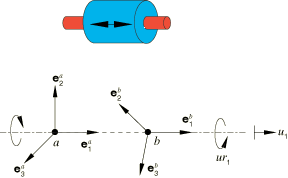CYLINDRICAL | |||||||||
|
| ||||||||
ProductsAbaqus/StandardAbaqus/ExplicitAbaqus/CAE
Description

Connection type CYLINDRICAL imposes kinematic constraints and uses local orientation definitions equivalent to combining connection types SLOT and REVOLUTE.
The connector constraint forces and moments reported as connector output depend strongly on the order and the location of the nodes in the connector (see Connector behavior). Since the kinematic constraints are enforced at node b (the second node of the connector element), the reported forces and moments are the constraint forces and moments applied at node b to enforce the CYLINDRICAL constraint. Thus, in most cases the connector output associated with a CYLINDRICAL connection is best interpreted when node b is located at the center of the device enforcing the constraint. This choice is essential when moment-based friction is modeled in the connector since the contact forces are derived on the connector forces and moments, as illustrated below. Proper enforcement of the kinematic constraints is independent of the order or location of the nodes.
![]()
Friction
Predefined Coulomb-like friction in the CYLINDRICAL connection defines the friction force (CSFC) along the instantaneous slip direction on the two contacting cylindrical surfaces (the pin and the sleeve) illustrated above. The table below summarizes the parameters that are used to specify predefined friction in this connection type as discussed in detail next.
The frictional effect is formally written as
where the potential represents the magnitude of the frictional tangential tractions in the connector in a direction tangent to the cylindrical surface on which contact occurs, is the friction-producing normal force on the same cylindrical surface, and is the friction coefficient. Frictional stick occurs if ; and sliding occurs if , in which case the friction force is .
The normal force is the sum of a magnitude measure of friction-producing connector forces, , and a self-equilibrated internal contact force (such as from a press-fit assembly), :
The magnitude measure of friction-producing connector contact force, , is defined by summing the following two contributions:
a radial force contribution, (the magnitude of the constraint forces enforcing the SLOT constraint):
a force contribution from “bending,” , obtained by scaling the bending moment, (the magnitude of the constraint moments enforcing the REVOLUTE constraint), by a length factor, as follows:
where L represents a characteristic overlapping length between the shaft and the outer sleeve in the 1-direction. If L is 0.0, is ignored.
Thus,
where .
The magnitude of the frictional tangential moment, is computed using
where R is an effective radius of the shaft cross-section in the local 2–3 plane. The potential represents the magnitude of connector tangential tractions on the cylindrical contact surface due to simultaneous translation and rotation. The instantaneous slip direction is a result of combined motion in these directions.
![]()
Summary
| ||||||||||||||||||||||||||